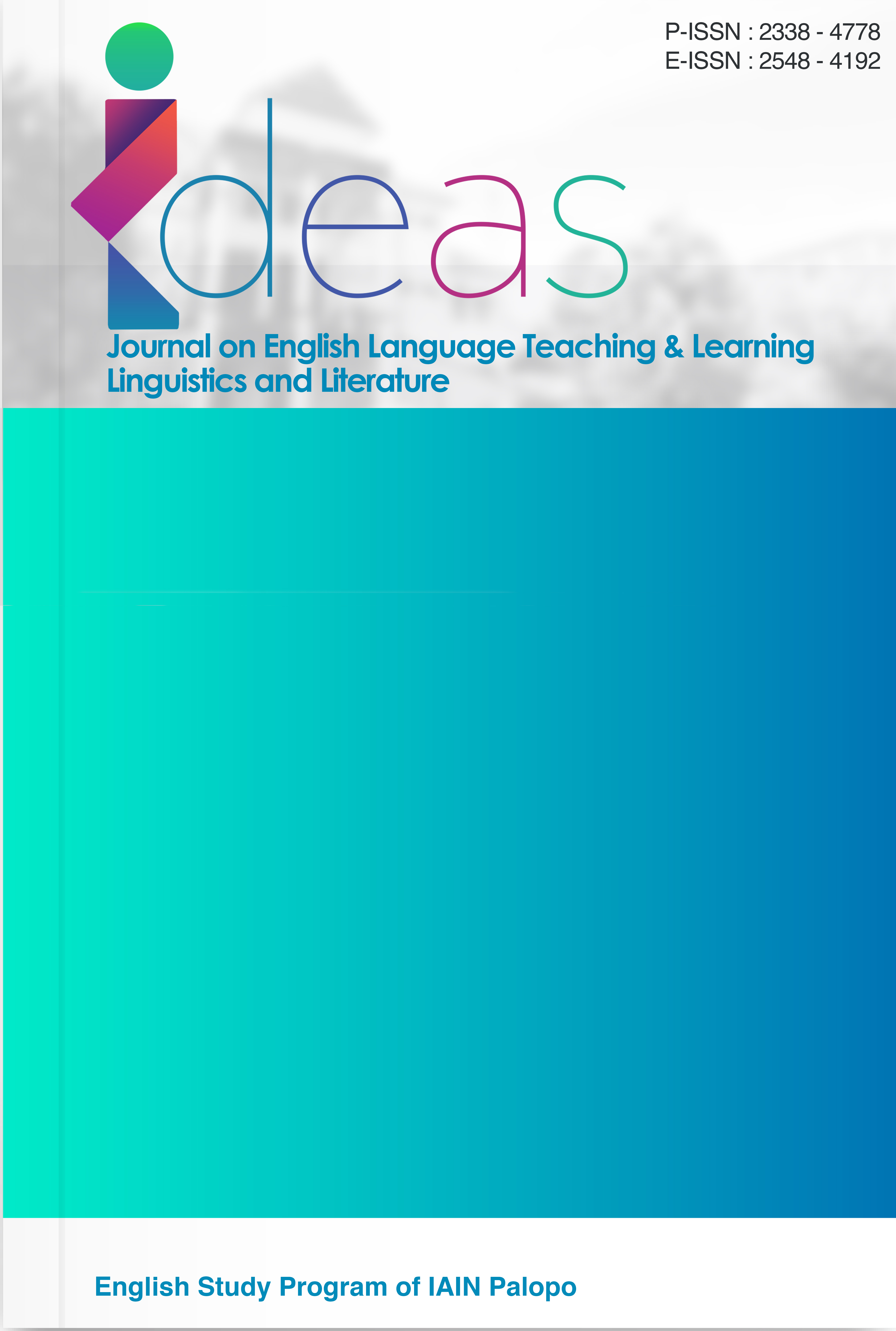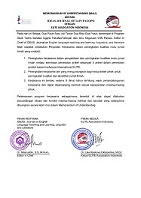The Implementation of Classpoint in Learning English: A Case Study of Students at State Islamic Senior High School Medan
DOI:
https://doi.org/10.24256/ideas.v13i2.8157Keywords:
classpoint, student, EnglishAbstract
The utilization of Information and Communication technology (ICT) in educational activities substantially enhances the quality of education, particularly in the context of the current industrial revolution 4.0. Classpoint is a learning platform that helps with IT- based learning. This study seeks to evaluate the application of Classpoint in English instruction for grade XI students at State islamic high school in Medan. This Study employs a qualitative methodology utilizing a case study design. Data were gathered via observation, interviews and documentation. The data analysis methodologies encompass data reduction, data presentation, and data conclusion formulation. To guarantee the data’s validity, triangulation of data, methodologies, and source was employed. This study’s findings indicate that classpoint is highly effective in facilitating English learning for eleventh- grade students at State islamic high school in Medan.
References
Bong, E. Y., & Chatterjee, C. (2021). The Use of a ClassPoint Tool for Student Engagement During Online Lesson. Proceedings of the Asian Conference on Education.
Classppoint. (2000). Interactive Classroom Quiz in PowerPoint. https://www.classpoint.io/. Diakses tanggal 15 Mei 2023
Eisenhardt, K. M. (1989). Building theories from case study research. Academy of Management Review, 14(4), 532–550.
Flyvbjerg, B. (2006). Five misunderstandings about case-study research. Qualitative Inquiry, 12(2), 219–245.
Latief, M. A. (2012). Research methods on language learning: An introduction. Malang: Universitas Negeri Malang.
Mazlan, N. A., Kim Hua, T., Othman, Z., & Wahi, W. (2023). ClassPoint Application for Enhancing Motivation in Communication among ESL Young Learners. World Journal of English Language, 13(5).
Miles, M. B., & Huberman, A. M. (1994). Qualitative data analysis: An expanded sourcebook. sage.
Perdani, Y. D. (2020). Using Videotaping Homework To Improve Speaking Ability. Journal of English Teaching, Applied Linguistics and Literatures (JETALL), 3(2), 75–82.
Stake, R. E. (1995). The art of case study research. sage.
Sundari, D. H., Iskandar, I., & Muhlis, M. (2021). Penerapan Media Presentasi Classpoint Untuk Meningkatkan Hasil Belajar Siswa Pada Mata Pelajaran Bahasa Inggris MAN 19 Jakarta. Jurnal Pemikiran Dan Pengembangan Pembelajaran, 3(3), 1–9.
Tan, K. H., Rajendran, A., Muslim, N., Alias, J., & Yusof, N. A. (2022). The Potential of TikTok’s Key Features as a Pedagogical Strategy for ESL Classrooms. Sustainability, 14(24), 16876.
Yin, R. K. (2018). Case study research and applications. Sage. Burgers, C., Konijn, E. A., & Steen, G. J. (2016). Figurative framing: Shaping public discourse through metaphor, hyperbole, and irony. Communication Theory, 26(4), 410–430. https://doi.org/10.1111/comt.12096
Clark, B. (2021). Pragmatics: The basics. In Pragmatics: The Basics. https://doi.org/10.4324/9781003197263
Dancygier, B., & Sweetser, E. (2014). Figurative language. Cambridge Textbook in Linguistics. www.cambridge.org
Forgács, B. (2022). The pragmatic functions of metaphorical language. In Language, Cognition, and Mind (Vol. 11). https://doi.org/10.1007/978-3-030-66175-5_4
Giora, R., & Filik, R. (2018). Introduction: Defaultness, affect, and figurative language. Metaphor and Symbol, 33(3). https://doi.org/10.1080/10926488.2018.1481260
Hussain, R. (2014). Metaphors and similes in literature. International Journal of Humanities and Social Science Invention ISSN (Online, 3(9), 2319–7722. www.ijhssi.org
Jogezai, F. (2020). Film theory and its application. International Islamic University, Islamabad, November. https://doi.org/10.7312/colm16973
Mackey, A., & Gass, S. M. (2022). Second language research methodology and design third edition (Third ed). Routledge. https://doi.org/DOI: 10.4324/9781003188414
Masruddin, M., Amir, F., Langaji, A., & Rusdiansyah, R. (2023). Conceptualizing linguistic politeness in light of age. International Journal of Society, Culture & Language, 11(3), 41-55.
Masruddin, M., & Nasriandi, N. (2022). Lexical and Syntactical Errors Performed by Junior High School Student in Writing Descriptive Text. IDEAS: Journal on English Language Teaching and Learning, Linguistics and Literature, 10(1), 1094-1100. doi:https://doi.org/10.24256/ideas.v10i1.3024
Melion, W. S., & Ramakers, B. (2016). Personification: An introduction. In Personification. https://doi.org/10.1163/9789004310438_002
Mukti, B. R., Novan, D., & Nugraha, S. (2022). Figurative language analysis in “Sing 2” movie by Garth Jennings: A semantics study. Ethical Lingua, 9(2), 2022. https://doi.org/10.30605/25409190.485
Padillah, E. N., Firmawan, H., & Purwaningsih, E. (2016). Simile, Hyperbole, Personification and Metaphor used in Gayle Forman’s If I Stay. Jurnal Ilmiah Sastra, 4(1).
Putra, G. A. B. S., Sudana, G. P., & Maharani, S. A. I. (2016). The figurative language in “Twilight” movie script. Jurnal Humanis, 16(3), 100–108. https://ojs.unud.ac.id/index.php/sastra/article/view/33786
Violita, V., & Cholsy, H. (2022). Speech Acts Equivalence of Audiovisual Translation on Enola Holmes Netflix Movie Subtitle. IDEAS: Journal on English Language Teaching and Learning, Linguistics and Literature, 10(1), 209-225. doi:https://doi.org/10.24256/ideas.v10i1.2589
Yule, G. (2020). The Study of Language 7th edition (7th ed). Cambridge University Press.
Zaimar, O. K. S. (2002). Majas dan pembentukannya. Makara, Sosial Humaniora, 6(2), 45–57.
Downloads
Published
Issue
Section
Citation Check
License
Copyright (c) 2025 Nikmah Fadillah Nasution, Rahmah Fithriani, Ahmad Amin dalimunthe

This work is licensed under a Creative Commons Attribution-ShareAlike 4.0 International License.
Authors retain copyright and grant the journal right of first publication with the work simultaneously licensed under an Attribution-ShareAlike 4.0 International (CC BY-SA 4.0) that allows others to share the work with an acknowledgement of the work's authorship and initial publication in this journal.
Authors are able to enter into separate, additional contractual arrangements for the non-exclusive distribution of the journal's published version of the work (e.g., post it to an institutional repository or publish it in a book), with an acknowledgement of its initial publication in this journal.
Authors are permitted and encouraged to post their work online (e.g., in institutional repositories or on their website) prior to and during the submission process, as it can lead to productive exchanges, as well as earlier and greater citation of published work (See the Effect of Open Access)




